A Guide to Leisure Batteries
Leisure battery construction and care
Whether you camp on a Club site with full electric hook-up or attend rallies with no mains electric supply a battery in your unit is an essential addition. This guide explains the construction and provides some guidance to buying and maintaining a leisure battery to enable a stress free holiday.
The 12V equipment in a caravan or motorhome relies on a leisure battery. This important item is not normally supplied with a new caravan whereas most new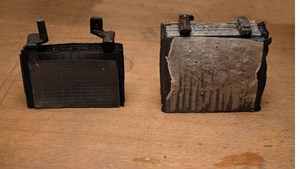 motorhomes have one as standard. Batteries that are designed to start a vehicle are made differently from batteries specifically intended to run caravanning appliances. This is because their operating requirements are different. For instance a vehicle battery has to provide a high current surge to start an engine, but once that has been achieved, a vehicle’s alternator immediately replenishes the power it provided.
motorhomes have one as standard. Batteries that are designed to start a vehicle are made differently from batteries specifically intended to run caravanning appliances. This is because their operating requirements are different. For instance a vehicle battery has to provide a high current surge to start an engine, but once that has been achieved, a vehicle’s alternator immediately replenishes the power it provided.
In contrast, a leisure battery has to provide a steady flow of current over a prolonged period and seldom gets replenished until the user recognises that its voltage level has substantially fallen. That’s when a re-charge is duly provided. If left long in a discharged state, a battery will generally not regain its former condition. Furthermore, manufacturers often recommend that re-charging is commenced when a battery drops to 50 per cent of its full condition.
To achieve the required performance, a leisure battery should be constructed in a way that copes better with a life of repeated significant discharging followed by re-charging. This is referred to as ‘deep cycling’ and other products that perform in this manner include ‘semi-traction’ and ‘traction batteries’, these are used on golf buggies, disability wheelchairs, and several types of warehouse vehicles. There's also 'uninteruptable power supplies' (UPS) batteries, capable of very deep cycling and withstanding a continuous charge too, these are found supporting servers, security systems and emergency medical facilities.
This guide focuses on lead-acid batteries which are manufactured for particular tasks but in recent years we've seen an increase in the availability of lithium batteries so they're now worth a mention. They also get classified using various names.
Types of conventional lead-acid batteries:
- Standard starter batteries (sometimes referred to as calcium batteries, cranking batteries, lead-acid batteries, wet batteries).
- Standard leisure batteries (also referred to as auxiliary batteries, deep-cycling batteries, lead-acid batteries, wet batteries).
- Semi traction and traction batteries (also referred to as deep cycling batteries, lead-acid batteries, wet batteries).
Products made differently such as gel, lead-crystal, lithium and AGM batteries are mentioned later in this guide.
Battery versatility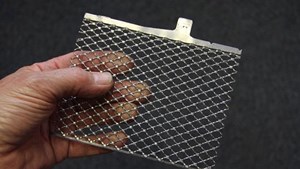
Not surprisingly, batteries are made to be ‘job specific’. For instance, a conventional car battery seldom lasts long when asked to provide a 12V supply in a caravan or motorhome. This is partly because its lead plates are thinner and its separators (described later) are different, too.
In consequence, it cannot cope with repeated heavy discharge and recharge cycles. Conversely, a standard ‘wet’ leisure battery doesn’t perform well as a starter battery either.
So bear in mind that conventional lead-acid batteries are not able to perform both starting functions and accessory supply functions with equal effectiveness. However, products called AGM batteries, described later, are better at performing both operations.
Leisure batteries’ two-fold tasks
Although a key function of a leisure battery is to run 12V appliances, it also performs a second important function. Bearing in mind that it is permanently linked to a caravan or motorhome’s built-in charger, a leisure battery is also able to smooth out any irregularities in the supply received from this device.
This is why a caravan’s 12V accessories should not be run directly from a charger – i.e. without a battery installed in the supply system.
Battery anatomy
The standard (i.e. ‘wet’) starter and leisure batteries described here usually have a polypropylene container (available in standardised sizes) and moulded with compartments.
Each compartment creates a nominal 2.12V, thereby creating a total of around 12.7V for a fully-charged battery.
Each compartment houses a series of positive and negative lead plates. These have a grid construction so that lead oxide paste can be pressed into all the apertures.

The plates in a genuine leisure battery are thicker than those used in starter batteries. Each plate is normally held in a microporous perforated plastic envelope called a separator.
Moreover, in a genuine leisure battery, these envelopes also contain glass fibre sheets to press against the lead oxide paste held in each plate. This combats the tendency during constant re-charging for the paste to become loosened and then completely detached from the lead grid.
The compartments in the casing of lead-acid batteries are also filled with diluted sulphuric acid referred to as the electrolyte. The casing also has a gas outlet for releasing any hydrogen created during re-charging. This must not be allowed to become detached.
 The greater amount of lead in a genuine leisure battery and its more elaborate separators is reflected in its higher price and increased weight.
The greater amount of lead in a genuine leisure battery and its more elaborate separators is reflected in its higher price and increased weight.
Non-wet leisure batteries
Gel batteries
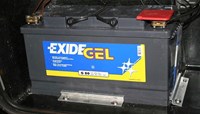
Some leisure vehicles, such as those used for off-road quad bikes and jet skis, have a greater likelihood of tipping over. An accidental inversion might also result in the loss of a battery’s corrosive acid which, in turn, might cause personal injury. In response to this, batteries are installed which have a non-spill electrolyte in the form of a gel. Unlike a ‘wet’ battery, a gel battery’s casing is completely sealed. Recently, some imported motorhomes have been fitted with a gel battery rather than a lead-acid battery, but this is for added safety during a crash. From an electrical perspective, batteries with a gel electrolyte are unlikely to perform any better than wet-acid types. Also be aware that when recharging a gel battery, the charge voltage must not exceed 14.2V. Information on charging requirements is a subject in its own right.
Absorbent Glass Mat (AGM) batteries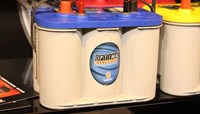
An AGM battery has lead plates in each cell and the manufacturer uses a machine to add highly compressed glass fibre into each compartment. The fibre then absorbs the acid electrolyte. During manufacture, air is also drawn from the casing and a pressure relief valve is fitted. These processes render the finished product more costly than a conventional ‘wet lead-acid’ leisure battery but AGM products can generally achieve many more recharging cycles – thereby achieving a longer working life.
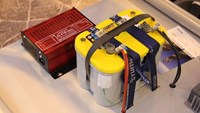 Some AGM batteries, such as the Banner Running Bull range, use conventional rectangular polypropylene cases whereas in Optima batteries the compressed glass wool is fitted in a roll configuration. This gives an Optima battery an appearance similar to a six-pack of drinks.
Some AGM batteries, such as the Banner Running Bull range, use conventional rectangular polypropylene cases whereas in Optima batteries the compressed glass wool is fitted in a roll configuration. This gives an Optima battery an appearance similar to a six-pack of drinks.
As mentioned earlier, AGM batteries are unusual in that they can act as starter batteries as well as leisure products. For instance, some recent cars are fitted with a supporting AGM second battery to run the many electronic aids now being installed. Similarly, their notable performance is recognised by caravanners wanting a task-specific support battery to specifically run a motor mover.
When recharging an AGM battery, the charge voltage must not exceed 14.4V but check this with the manufacturer.
Lead-crystal batteries
As its name suggests there's broadly the same basic chemistry going with a reaction between lead and an acid but with these the acid is in a crystal form. This means there's very little liquid content with no risk of spillage making them safe to transport. The unique chemistry enables them to be very deep cycled with little risk of sulphation. They can be be around twice the price of a good quality deep-cycle battery but as they were originally designed for UPS use they're robust against continuous charging from a solar supply and can tolerate heavy discharge loads from an inverter for example.
Lithium batteries
Lithium iron phosphate (LiFePO 4) batteries are another form of very deep cycle battery. They're self contained units with their own on-board charge manager. Having elminated lead they typically weigh half as much as an equivelant output lead-acid battery so the weight saving is a benefit. They can also be fully discharged and recharged and during the discharge cycle they can retain a stable voltage level and they can be rapidly recharged.
Cost is the issue, they can typically be more than five times the price of a good quality lead-acid battery.
Maintenance-free batteries
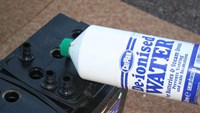 Conventional lead-acid starter and leisure batteries have inspection caps so that the level of acid can be inspected in each of the cells. This also enables the cells to be topped-up using de-ionised water (also sold for steam irons) so that the electrolyte just covers the top of the lead plates.
Conventional lead-acid starter and leisure batteries have inspection caps so that the level of acid can be inspected in each of the cells. This also enables the cells to be topped-up using de-ionised water (also sold for steam irons) so that the electrolyte just covers the top of the lead plates.
In gel and AGM batteries, cell checks are neither required nor possible because their polypropylene casings are sealed. However, some conventional ‘wet’ batteries equipped with removable cell caps are also being marketed as ‘maintenance free’ products. This is based on the fact that if a starter or leisure battery is not charged at a rate in excess of 14.6V, it seldom needs topping-up with de-ionised water. However, that is not the case when periodic boost charges of 14.8V or more are desirable for reviving a flagging battery. It then becomes very important to check the electrolyte level and replenish it with de-ionised water if necessary.
Safety
A lead-acid battery must be securely mounted and its gas escape vent fitted correctly. This discharges the mix of hydrogen and oxygen created during higher charging levels. The gases can either be safely taken outside for dispersal via a plastic tube or discharged through a specially-ventilated battery-locker door. In some cases the discharge of gas might be sufficient to activate a nearby gas alarm such as a carbon-monoxide detector.
Battery gas is explosive and if it is ignited, the casing of a battery can be blown apart and its acid released, leading to eye injury or flesh burns. Accordingly, when charging a battery or disconnecting leads after a charge, ensure there are no naked flames nearby. Even a lighted cigarette can ignite the gas. Also follow these precautionary measures whenever the electrolyte is checked and when a cell is topped-up:
- When inspecting battery cells, wear safety clothing including eye protection and gloves. Battery acid also damages clothing.
- Whereas a 12V battery is unlikely to cause electrocution, if the terminals or their couple cables are shorted-out, it can cause a fire.
- Sparks sometimes occur when connecting up a battery and good quality clamps are needed. Temporary crocodile clips, often supplied with battery chargers, are not suitable for permanent connections. Also note that a spark can cause ignition of releasing gas or residual gas left in a cell.
Purchasing guidance
The fact that there are different types of batteries made in different sizes and sold at dissimilar prices can confuse anyone wanting to purchase a leisure battery. Experience certainly reveals that some of the cheaper and lighter products not only lose their charge remarkably quickly but their working life is short as well. As a rule of thumb the heavier the battery the more lead it contains and therefore has the ability to hold a larger capacity of charge. If you want a leisure battery to provide power to perform deep cycling a heavy battery is a good place to start.
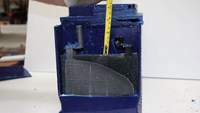 Due to the a huge variation in quality, price and actual performance, the leisure industry working with The National Caravan Council (NCC) has introduced a Leisure Battery Verification Scheme to make selection of a suitable quality battery easier and provides confidence that the battery purchased is fit for purpose and will perform as advertised. Assuming a tested leisure battery performs as required it will be categorised in one of three groups and approval logo (see RH column) will be applied to the battery.
Due to the a huge variation in quality, price and actual performance, the leisure industry working with The National Caravan Council (NCC) has introduced a Leisure Battery Verification Scheme to make selection of a suitable quality battery easier and provides confidence that the battery purchased is fit for purpose and will perform as advertised. Assuming a tested leisure battery performs as required it will be categorised in one of three groups and approval logo (see RH column) will be applied to the battery.
In some instances an inexpensive battery might meet the needs of some caravan or motorhome owners, especially if you spend most of your overnight stops at sites equipped with 230V mains hook-ups. When connected to a mains supply, a caravan’s battery is then only acting as a device that ‘smoothes out’ the 12V output from the ‘van’s built-in charger. Since the battery is seldom operating as a provider of power, an inexpensive battery might be a suitable purchase.
That is not the case if your caravanning and motorhome trips take you to Certificated Sites without electric hook-ups or Club rally sites where you have to be fully self-contained. In those situations, a good quality, high capacity battery is essential for running 12V appliances. Equally, if you enjoy extended stops on a site of your choice and neither tow a caravan nor drive a motorhome off-site for several days, your leisure battery won’t get re-charged from a vehicle alternator either. So a good leisure battery is needed in that instance, too. Only buy batteries that have been manufactured in the last 12 months. Ask the supplier this question as old batteries could already be sulphated (see battery care).

The categories are:
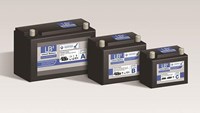
- Category A is for higher storage capacity for people who frequently use their caravans or motorhomes away from electrical hook-ups
- Category B are aimed at those who frequently use sites with hook-up facilities, but require a greater battery capacity to operate devices such as motor movers
- Category C is for users that require a lower capacity battery to cover basic operation of their habitation equipment for short periods away from a hook-up
Battery care
To get the best out of a leisure battery:
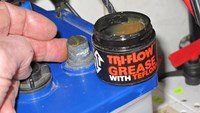
- Apply a thin film of grease or petroleum jelly, such as Vaseline, to a battery’s terminals (see right).
- Use good quality battery clamps and if you prefer spring-loaded clamping clips, make sure that their steel contact surfaces don’t start to rust
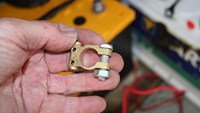 On a non-sealed battery, periodically confirm that the electrolyte covers the lead plates. Before inspecting the cells, ensure there are no naked flames or lit cigarettes nearby. Wearing safety spectacles is also a wise precaution. Periodically check that a battery’s gas relief tube (where fitted) is correctly coupled-up.
On a non-sealed battery, periodically confirm that the electrolyte covers the lead plates. Before inspecting the cells, ensure there are no naked flames or lit cigarettes nearby. Wearing safety spectacles is also a wise precaution. Periodically check that a battery’s gas relief tube (where fitted) is correctly coupled-up.
- Battery manufacturers often strongly advise that a battery receives a re-charge when its capacity falls below 50 per cent of its full condition. It is also added that you should never run a leisure battery until it is virtually ‘flat’. Further details are covered in the battery charging guide.
- If a caravan or motorhome is unused for a long spell, provision must be made to keep its leisure battery charged. A trickle charger is often used to maintain the state of charge.
- Some owners remove a battery and transfer it to a bench where it can be maintained – but don’t forget that this may disable any electrically-powered security alarms.
Keep it charged
 Never leave a battery in a discharged state. If recharging is delayed, a situation known as sulphation occurs in which a white deposit forms on a battery’s plates. In general this is an incurable condition, which renders a battery useless.
Never leave a battery in a discharged state. If recharging is delayed, a situation known as sulphation occurs in which a white deposit forms on a battery’s plates. In general this is an incurable condition, which renders a battery useless.
Checking a battery’s charge level
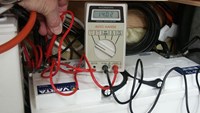 Most caravan control panels have a light display or battery condition meter, some of which don’t provide a precise indication of its charge level. More accurate information is obtained by taking a reading across a battery’s terminals using a digital meter. When using a hand-held meter, note the following points:
Most caravan control panels have a light display or battery condition meter, some of which don’t provide a precise indication of its charge level. More accurate information is obtained by taking a reading across a battery’s terminals using a digital meter. When using a hand-held meter, note the following points:
- All electrical appliances should be switched off. If you don’t want to disconnect a clock, an alarm that runs from the battery, a fridge’s fascia controls or similar, the reading will not be completely accurate. Obviously this is not an issue if you’ve removed a battery and transferred it to a work bench.
- If you have recently disconnected a charger or have been driving a motorhome or towing, a reading will be higher than normal. After a battery has been receiving a charge, it is recommended to let it settle for at least four hours before taking a voltage reading.
- Now you need to interpret the reading and although we talk about 12V batteries and accessories, this description is only nominal. If a leisure battery achieves a 12V reading, it is considered to have reached a discharged state.
As a rough guide, work to the following table:
| Voltmeter reading | Approx state of charge |
|---|---|
| 12.7V or over | 100% |
| 12.5V | 75% |
| 12.4V | 50% |
| 12.2V | 25% |
| 12V or under | Discharged |
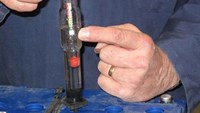 Battery specialists sometimes diagnose a lead-acid battery’s condition using a hydrometer to obtain the specific gravity of the acid. Although this method has some advantages, it cannot be used on a sealed battery and the procedure is not discussed further here.
Battery specialists sometimes diagnose a lead-acid battery’s condition using a hydrometer to obtain the specific gravity of the acid. Although this method has some advantages, it cannot be used on a sealed battery and the procedure is not discussed further here.
Performance period between charges
The capacity of a battery should determine how long a battery can provide power before it needs to be recharged. Some are more highly specified than others and the idea of having greater or lesser capacities is expressed in Amp hours (Ah). So a 110Ah battery provides power for a longer period than a 65Ah battery; it also takes longer to recharge completely. However, there are many other factors that influence whether recharging is needed sooner or later.
Factors affecting battery performance
- Temperature – The stated capacity of a battery is expressed in Amp hours (Ah) but the quoted figure is only applicable when the ambient temperature is 25C. In reality, there are many occasions in the UK when it’s much colder than 25C and for every one degree drop in temperature, there’s an approximate one per cent reduction in a battery’s Ah capacity.
Let’s take an example. If a battery which is nominally rated at 60Ah is operating in temperatures of 15C, this ten degree reduction will bring about a 10 per cent reduction in its capacity. This now means that it effectively performs like a 54Ah battery. The temperature issue can have adverse effects for caravan and motorhome users who enjoy winter sports. Not only will a battery face greater demands when providing their lighting, fan-assisted heating, and evening TV entertainment during long, dark evenings; its effective capacity is significantly lower than it would be in warmer conditions.
Needless-to-say, if a battery box is mounted inside, heat in the living area will help to improve its performance. However, many batteries are mounted externally where ambient temperatures can be much lower.
- Battery age – As a battery gets older, its performance deteriorates and it needs re-charging with increasing frequency, therefore, it is unlikely to last more than five years.
- Higher rates of consumption – If numerous appliances are being used simultaneously, a battery’s increased discharge rate affects its ability to provide power. This is not just a matter of saying that running appliances with double the wattage results in a battery becoming discharged in half the time. In practice, an extra demand on a battery has an even greater effect on its power-providing potential. Or to put it another way, the faster your battery is discharged, the lower its capacity will be.
- What size leisure battery do I need? – You will first need to work out what your consumption is going to be on the 12V equipment you use and for how long it is used then, if required, factor in what seasons you go away. An example is shown below:
|
Equipment(Typical example) |
Current(Amps) |
Multiply |
Hours of use |
= |
Amp hour rating (AH) |
|---|---|---|---|---|---|
| One fluorescent tube | 0.75 | x | 5 | = | 3.75 |
| 2 halogen lights | 1.50 | x | 3 | = | 4.50 |
| LCD TV | 2.5 | x | 4 | = | 10.00 |
| TV booster | 0.05 | x | 4 | = | 0.20 |
| Water pump | 0.7 | x | 0.5 | = | 0.35 |
| Motor mover | 30 (Average) | x | 0.3 | = | 9.00 |
| Sub Total | = | 27.8 | |||
|
(For winter use add an extra 10%) |
Add 20% safety margin | = | 5.56 | ||
| Total Ampere Hours required per day | = | 33.36 |
This gives your typical daily consumption. It is surprising how much power is required and how we take it for granted. Heavy consumption equipment like motor movers will have a detrimental effect on the battery performance for the reasons explained below.
From this information decide what size battery will likely be needed depending on how long you are away from a charging source. It is likely that this is not enough to meet your needs and will have to consider a top up charge. This will be covered in more depth in the Battery Charging guide.
- Rate of discharge – Following on from the above point, a battery’s ability to provide power will depend on the rate of discharge. Time plays a key part and that is why batteries built to meet EU 50342 standards have two or sometimes three Ah capacities marked on their labels. Normally a manufacturer’s quoted Ah capacity of a battery is based on a discharge time of 20 hours – referred to as ‘the 20 hour rate’. For instance, a battery designated as 95Ah at the 20 hour rate might only achieve 80Ah at a five hour rate – or as much as 105Ah if educed demand extends over a 100-hour period.
Unfortunately there are so many different factors involved in a battery’s actual performance, its Ah capacity can only be taken as a guide. The type of battery design and construction, ambient temperature, battery age, and consumption levels have already been mentioned. In practical terms, nearly all caravanners find their battery seems to need recharging far sooner than they expected.
For further information
See our guide Charging a leisure battery
Thank you to John Wickersham (www.wickyworld.co.uk) and Banner Batteries(www.bannerbatterien.com) for their kind help producing this guide.
